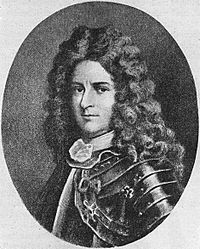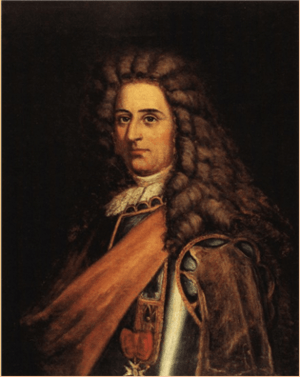Naval battle off St. John (1696) facts for kids
Quick facts for kids Naval battle off St. John |
|||||||
|---|---|---|---|---|---|---|---|
| Part of the King William's War | |||||||
 Pierre Le Moyne d'Iberville |
|||||||
|
|||||||
| Belligerents | |||||||
| Commanders and leaders | |||||||
| Strength | |||||||
| 2 ships of the line with a province tender | 2 ships of the line | ||||||
| Casualties and losses | |||||||
| 1 ship captured | none | ||||||
The Naval Battle off St. John was a sea fight that happened on July 14, 1696. It was part of King William's War, a big conflict between France and England. This battle took place in the Bay of Fundy, near what is now Saint John, New Brunswick. English ships from Boston were trying to stop French supplies. These supplies were for French officer Pierre Le Moyne d'Iberville and were headed to Fort Nashwaak (now Fredericton, New Brunswick). During the battle, two French warships, the Envieux and the Profond, captured an English ship called the Newport. Another English ship, the Sorlings, managed to get away.
Why the Battle Happened
King William's War and French Plans
In 1696, King William's War had been going on for seven years. A French officer named Pierre Le Moyne d'Iberville was planning a big attack. He wanted to capture a strong English fort called Pemaquid in what is now Maine.
To get ready, D'Iberville sailed from France to Quebec City. There, he picked up 80 soldiers and Canadians. Then, he went to Cape Breton, where 30 Mi'kmaq warriors joined his group. They were all heading to the St. John River.
English Ships in the Bay of Fundy
While D'Iberville was nearby, he heard that two English ships were in the Bay of Fundy. These ships were trying to stop French supplies from reaching Fort Nashwaak. D'Iberville decided to try and capture these English ships.
A few days before the main battle, on July 5, a group of 140 Mi'kmaq and Maliseet warriors, led by Jacques Testard de Montigny, attacked some English sailors. The English were coming ashore to get firewood. The warriors killed five of the nine men and burned one of their small boats.
The Battle Begins
On July 14, D'Iberville's ships were anchored in thick fog, about five leagues (around 15 miles) from the St. John River. Around 2:00 PM, the fog started to clear. The French ships could see three English vessels sailing directly towards the St. John River.
When the English ships were about one league (three miles) away, they saw the French ships. The English ships then turned and headed straight for the French.
A Clever Trick
The French ship Profond, commanded by Simon-Pierre Denys de Bonaventure, used a clever trick. It kept its gunports (the openings for cannons) closed. This made it look less like a warship.
Both English ships started firing at the French ships. But when the Profond was close enough, Bonaventure opened its gunports. The English ships quickly realized they were outgunned. They tried to escape by sailing away quickly.
The Chase and Capture
The Profond tried to catch up to the English ships. D'Iberville, on his ship the Envieux, followed closely, even though the weather was stormy.
D'Iberville's ship, the Envieux, fired at the English frigate Newport, which was commanded by Captain Paxen. The shots hit the Newport so hard that its masts were broken. The damaged Newport drifted closer to the Envieux and then lowered its flag, meaning it surrendered.
D'Iberville left the Newport for Bonaventure's crew to take over. They tried to take it to the St. John River, but it almost got stuck on some rocks.
D'Iberville and the Envieux kept chasing the bigger English ship, the Sorlings, commanded by Captain Eames. The French ship's cannonballs flew past the Sorlings. The chase lasted for three hours, but then night and fog returned. The English ship Sorlings managed to escape in the darkness and fog.
What Happened Next
On July 15, the day after the battle, D'Iberville entered Saint John Harbour. He dropped off supplies for Fort Nashwaak, which was the capital of Acadia at the time.
D'Iberville also picked up 50 more Mi'kmaq warriors and a priest named Pere Simon. On August 2, 1696, they sailed to Penobscot (which is now Castine, Maine). While at St. John, D'Iberville also repaired the captured Newport and added it to his fleet.
At Penobscot, they met up with more French and Native American allies. On August 14, D'Iberville led them all in the Siege of Pemaquid (1696), where they successfully captured the English fort.
Meanwhile, the Sorlings, the English ship that escaped, sailed back to Boston. In Boston, the Sorlings found two other English warships and an armed merchant ship. These four ships then sailed east to help defend against a possible French attack on Portsmouth. The English ships spotted the French ships Envieux and Profond near Mount Desert, but the French ships were able to get away.


